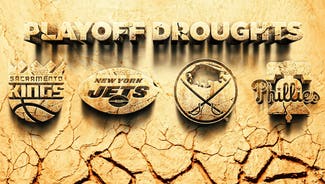
Olympic hockey, playoffs making NHL cool again
Not too long ago, wearing Chicago Blackhawks gear would earn you quizzical looks or jokes about being the last of the team's fans.
Now the Blackhawks are the talk of the entire town.
"So many more people are talking about the Blackhawks, you need to follow them just to have a conversation," converted fan Paul Zywicki said.
The buzz isn't limited to Chicago. Fueled by a thrilling Olympic tournament in time-zone friendly Canada and down-to-the-wire playoff series involving some of the league's most storied franchises, the NHL is the hottest it's been since the pre-lockout days.
Television viewership in the United States is the highest in eight years, arenas have been filled to capacity - and then some - during the playoffs, new sponsors are signing up and merchandise sales are on the rise.
"As an athlete and as a hockey player, you feel like the third, maybe fourth or even fifth place in the sporting world," Blackhawks forward Adam Burish said. "But you can sense as you go around to the different cities, and especially here in Chicago, that hockey's exploding. It's bigger than it ever was."
Already trailing the NFL and NBA in popularity, the NHL was in danger of becoming a niche sport after a lockout wiped out the 2004-05 season. It typically takes several years for any league to recover from labor strife, and there were a few factors making the NHL's return to relevance even tougher.
Most of the NHL's television package was moved to OLN (now Versus), which doesn't have nearly the reach as old partner ESPN. The first two Stanley Cup finals after the lockout were Carolina vs. Edmonton and Anaheim vs. Ottawa, teams that lacked the big names and buzz that can attract casual fans and create new ones. Chicago, home to one of the Original Six franchises and the country's third-largest media market, was a nonentity, mustering a season ticket base of just 3,400 in 2007.
The Olympic tournament at the 2006 Turin Games was a yawner, too. Sweden and Finland played for the gold medal while Canada and the United States finished at the bottom of the standings.
This year, however, the NHL hit the popularity jackpot.
"I think a big part of it was the Olympics," Philadelphia Flyers forward Daniel Carcillo said. "What a tournament that was. The final game brought a lot of hype around hockey."
Indeed, hockey at the Vancouver Games couldn't have gone more perfectly had it been scripted, with Canada and the United States playing for the gold medal. Sidney Crosby, the NHL's biggest name along with Alex Ovechkin, scored the winning goal in overtime for Canada. It was only the second gold medal since 1952 for the hockey-crazed nation.
Televised on NBC, it was the most-watched hockey game in the United States in 30 years, drawing an average viewership of 27.6 million.
While NHL commissioner Gary Bettman called the Olympic impact a "mixed bag," players had no doubts about its importance. Burish recalled going to a restaurant with some of the other Blackhawks to watch the Olympic final, and finding it packed with cheering fans.
"A couple of years ago, especially here in Chicago, hockey wasn't relevant. They wouldn't have cared," Burish said. "And here they are, cheering for a game that's not even the Blackhawks."
That enthusiasm has carried over into the playoffs, where 10 of the first 12 series went six games or longer.
NBC averaged 1.89 million viewers for the first three rounds of the playoffs, best since 2002. The overnight rating for Monday night's matchup between Chicago and Philadelphia was a 4.1, the best on record for a Game 2 of the Stanley Cup finals and a 21 percent increase from last year.
The average overnight rating for the first two games is 3.5, the highest it's been since 1999 and a 17 percent improvement from 2009.
Arenas have been filled to 102 percent of capacity, the NHL said, including the sellout-plus crowd of 22,275 for Monday night's game at the United Center. Unique visitors to NHL.com increased 31 percent, the league said, with page views up 51 percent.
Corporate sponsors for the NHL rose 20 percent this year, including new partnerships with Geico, Starwood Hotels and LG Electronics. League revenues should be up 4 percent this year, Bettman said.
Sales of merchandise at playoff venues are 10 percent higher than last year, and the NHL's online store has seen a 31 percent increase.
To get an idea of what those numbers really mean, wander through the United Center, a building that was practically empty three years ago. Now the Blackhawks are the hottest ticket in town, with 101 straight sellouts dating to the 2007-08 season.
Almost everyone at Monday's game wore a Blackhawks jersey or T-shirt. Not the Hull, Esposito or Chelios sweaters that used to be the mainstays, either. No, most fans, young and old, were decked out in Toews, Kane or Niemi jerseys, young players who will be the mainstay of the league for years to come.
"It indicates what we've always believed, that it's an exciting game and we just need people to recognize it," said Brendan Shanahan, a three-time Stanley Cup champion who is now the NHL's vice president of hockey and business development.
"Going from a player to this side, one of the exciting parts for me is just seeing so much potential for the game of hockey," Shanahan said. "I think we're just getting there."

